Wearable Medical Devices Market Size
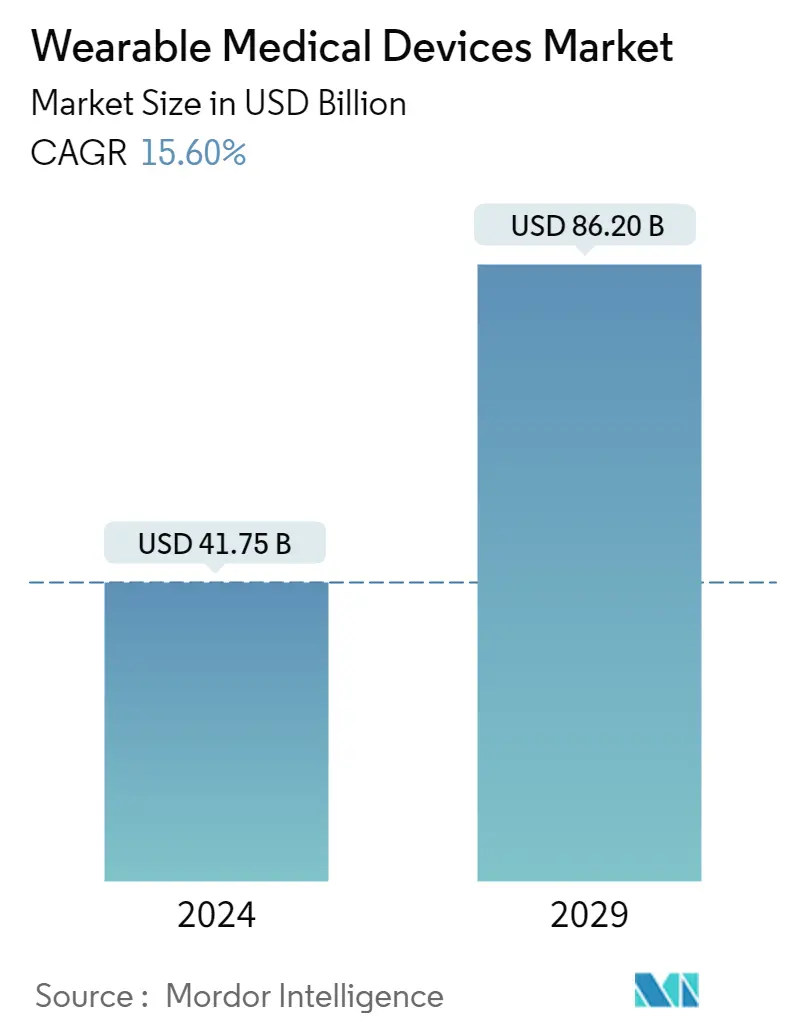
| Study Period | 2021 - 2029 |
| Market Size (2024) | USD 41.75 Billion |
| Market Size (2029) | USD 86.20 Billion |
| CAGR (2024 - 2029) | 15.60 % |
| Fastest Growing Market | Asia Pacific |
| Largest Market | North America |
Major Players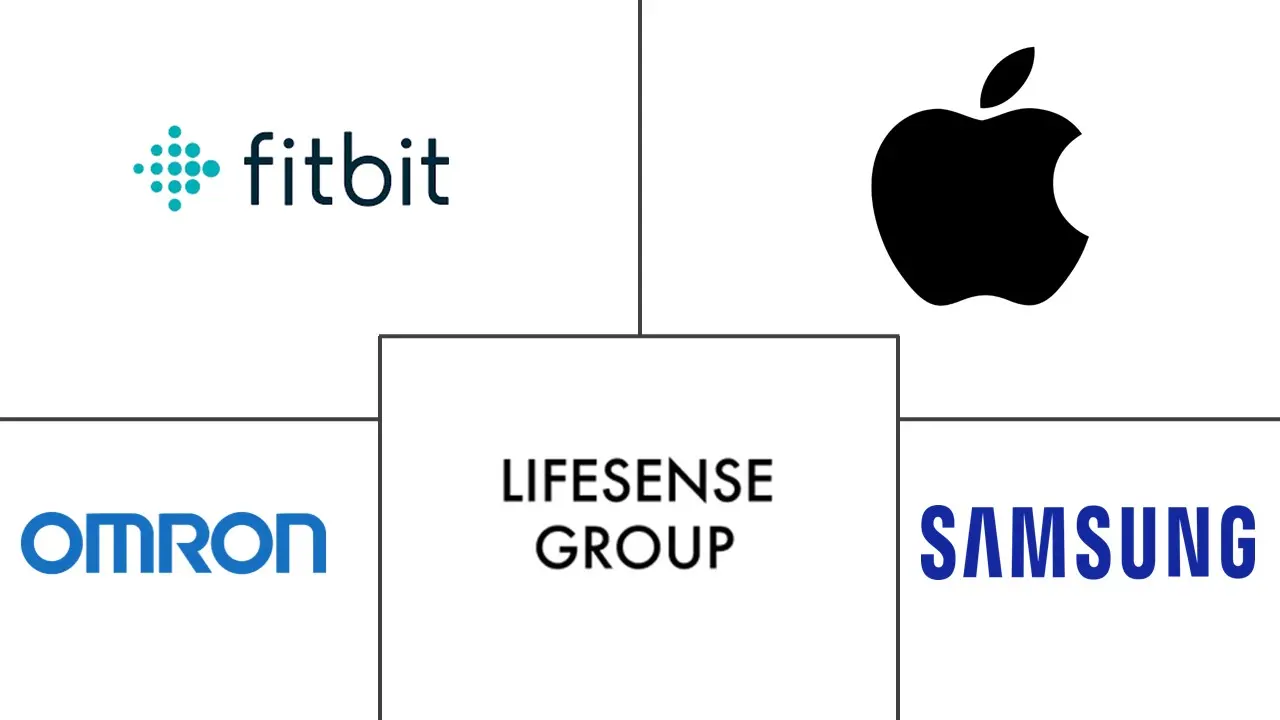
*Disclaimer: Major Players sorted in no particular order |
Need a report that reflects how COVID-19 has impacted this market and its growth?
Wearable Medical Devices Market Analysis
The Wearable Medical Devices Market size is estimated at USD 41.75 billion in 2024, and is expected to reach USD 86.20 billion by 2029, growing at a CAGR of 15.60% during the forecast period (2024-2029).
Wearable devices play a crucial role in predicting certain disorders by integrating essential vital signs with clinical symptomology. The use of wearable devices in a bid to combat COVID-19 has therefore been ramped up. Research has recently expanded on whether the extensive data that wearable devices collect can predict the onset of the virus or not.
For instance, according to a study published in NCBI in July 2022, 22 distinct types of wearable technology devices, such as smartwatches or fitness trackers, medical devices, and others, are utilized to identify COVID-19 infections. Such a huge adoption of wearable medical devices during the pandemic has been expected to drive market growth. Furthermore, post-pandemic, the market is expected to drive swiftly due to the rise in the adoption of wearable devices to track key health indicators.
The wearable medical devices market is growing at a faster pace owing to the rising technological innovations and advancements, as they can improve the lifestyle of the general population as well as the patient population. Wearable technologies offer a convenient mode of monitoring physiological symptoms, featuring a multitude of medical solutions. These devices are not only easy for consumer use but also offer real-time data for physicians to analyze. From the Apple Watch's EKG capabilities to new continuous glucose monitoring systems, wearable medical technologies have a broad range of potential applications in the healthcare industry.
The rise in the launch of wearable devices by the key market players is expected to propel market growth due to the rise in the adoption of such devices to monitor key health indicators. For instance, in August 2022, GOQii launched Smart Vital Ultra and GOQii Stream devices targeted at young adults and youth. These two products help enable consumers to monitor their vitals with ease.
Also, fundraising by companies to adopt innovative technologies such as implementing artificial intelligence (AI) technology in a wearable device to measure vital signs are anticipated to drive the market growth over the forecast period due to the rise in adoption of the technologically advanced product. For instance, in February 2022, Respira Labs closed a USD 2.8 million financing round to continue developing and manufacturing its chest wearable that uses acoustic resonance to assess lung function and identify changes in lung air volume, which is especially important for COPD, COVID-19, and asthma patients.
However, factors such as the lack of awareness about the availability of some wearable devices in developing and underdeveloped countries and the high cost of wearable devices are some of the major challenges to the growth prospects of the market.
Wearable Medical Devices Market Trends
Remote Patient Monitoring is Expected to Exhibit the Fastest Growth Rate Over the Forecast Period
The implementation of Remote Patient Monitoring (RPM) may improve the management of chronic disorders by measuring critical risk indicators, such as blood pressure and glucose. RPM has several advantages for hospitals and end users, such as a reduction in extended hospitalization, a low cost of healthcare, and fewer doctor appointments. This can also help lower the costs associated with the treatment of chronic disorders.
The increase in the number of people with chronic disorders and the rising elderly population are the major factors boosting the growth of RPM services across the globe. According to the British Heart Foundation, in August 2022, in the UK, there are currently 7.6 million people living with heart and circulatory diseases. However, as the population ages and expands and as survival rates from heart and circulatory events improve, these numbers may continue to rise. Such a high prevalence of chronic diseases in developed countries is anticipated to further increase the demand for remote patient monitoring devices, driving this segment's growth.
Furthermore, the rise in initiatives from the key market players to launch their innovative remote patient monitoring devices in the market is anticipated to bolster the market growth of this segment further. For instance, in March 2022, BioIntelliSence launched a medical-grade BioButton rechargeable wearable device for remote patient care. The device allows for continuous multi-parameter monitoring of a broad range of 20+ vital signs and physiologic biometrics.
Therefore, owing to the above-mentioned factors, this segment is expected to drive over the forecast period.
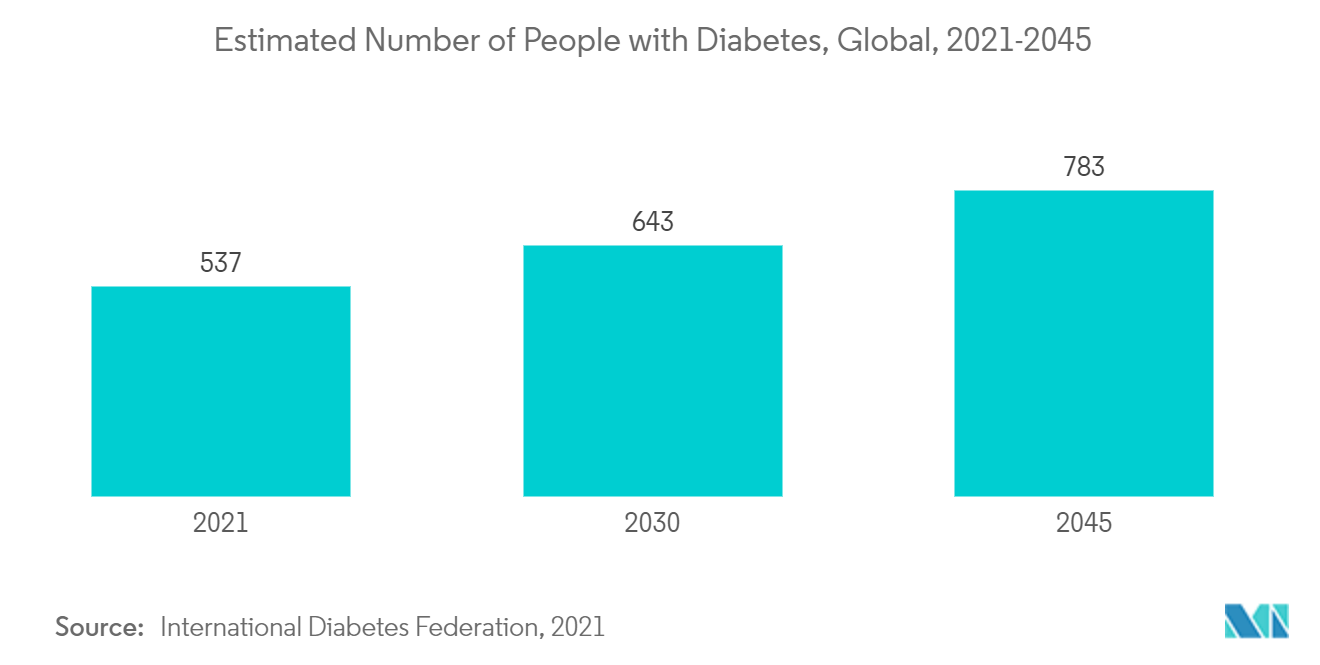
North America Holds a Significant Market Share and It is Expected to Retain its Dominance over the Forecast Period
North America is expected to hold a significant share of the overall wearable medical devices market, with the United States emerging as the major contributor to the market.
The United States holds the largest share in the wearable medical devices market due to the high prevalence of cardiovascular and lifestyle-related diseases and increased adoption of wearable medical technology, along with high per capita medical expenditure. Additionally, the strong foothold of major players such as Garmin Ltd, Fitbit Inc., and Biotelemetry Inc. are concentrated in the United States and have been investing in the research and development of innovative wearables.
Rising partnerships for the distribution of wearable medical devices in the United States are expected to drive the growth of this market in this region due to the rise in adoption. For instance, in April 2022, Medtronic plc entered into a strategic partnership with BioIntelliSense for the exclusive United States hospital and 30-day post-acute hospital-to-home distribution rights of the BioButton multi-parameter wearable for continuous, connected monitoring.
Furthermore, the rise in approval of wearable devices by the FDA is further expected to surge the market growth due to the development of innovative devices from the market players. For instance, in June 2022. the FDA-approved Medicalgorithmics' ECG wearable unit, Qpatch. This ECG wearable device has been designed to measure individual ECG signals and obtain accurate cardiac arrhythmia diagnoses from monitoring sessions of up to 15 days.
Therefore, owing to the above-mentioned factors, the North American region is expected to show significant growth due to the rise in the adoption of technologically advanced wearable medical devices, the rise in healthcare expenditure, and the rise in initiatives from the key market players.
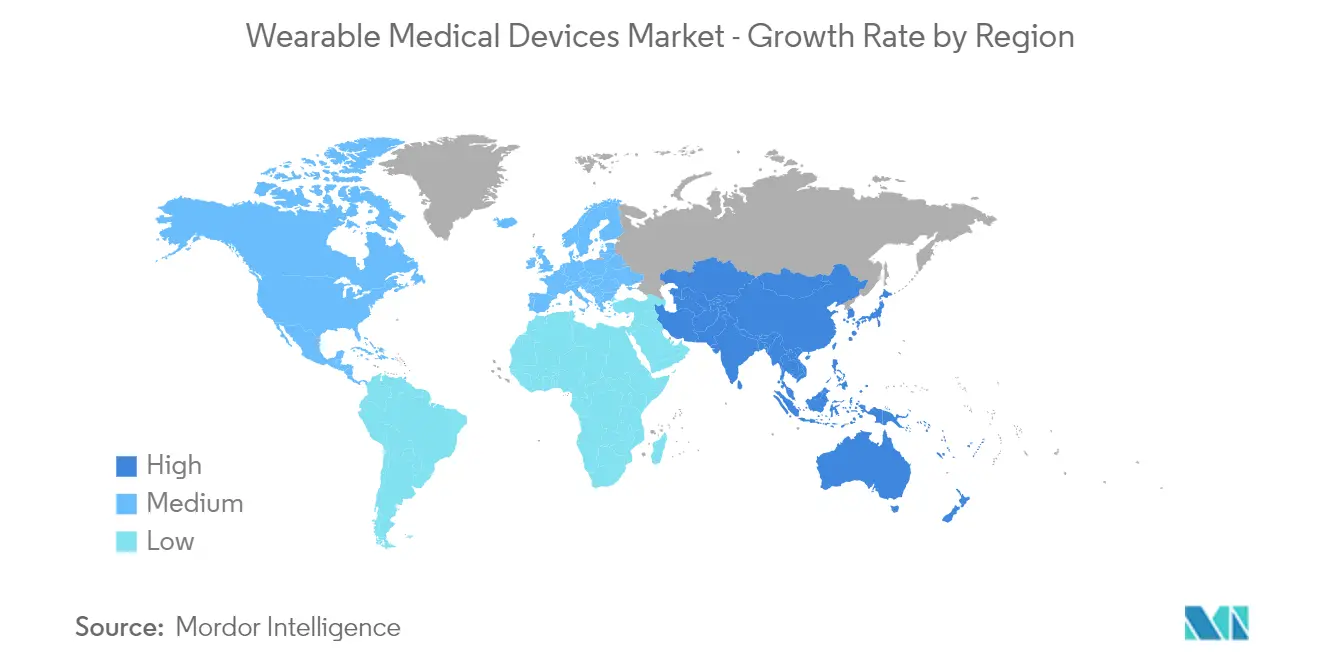
Wearable Medical Devices Industry Overview
The wearable medical devices market is fragmented due to the presence of many players operating in the market. The market is driven by the launch of innovative products by the players, technological advancements, and emerging new market players, among others. Some of the market players operating in this market include Fitbit, Lifesense, Apple, Omron Corporation, and Samsung, Philips, among others.
Wearable Medical Devices Market Leaders
-
Lifesense
-
Apple
-
Samsung
-
Fitbit
-
Omron Corporation
*Disclaimer: Major Players sorted in no particular order
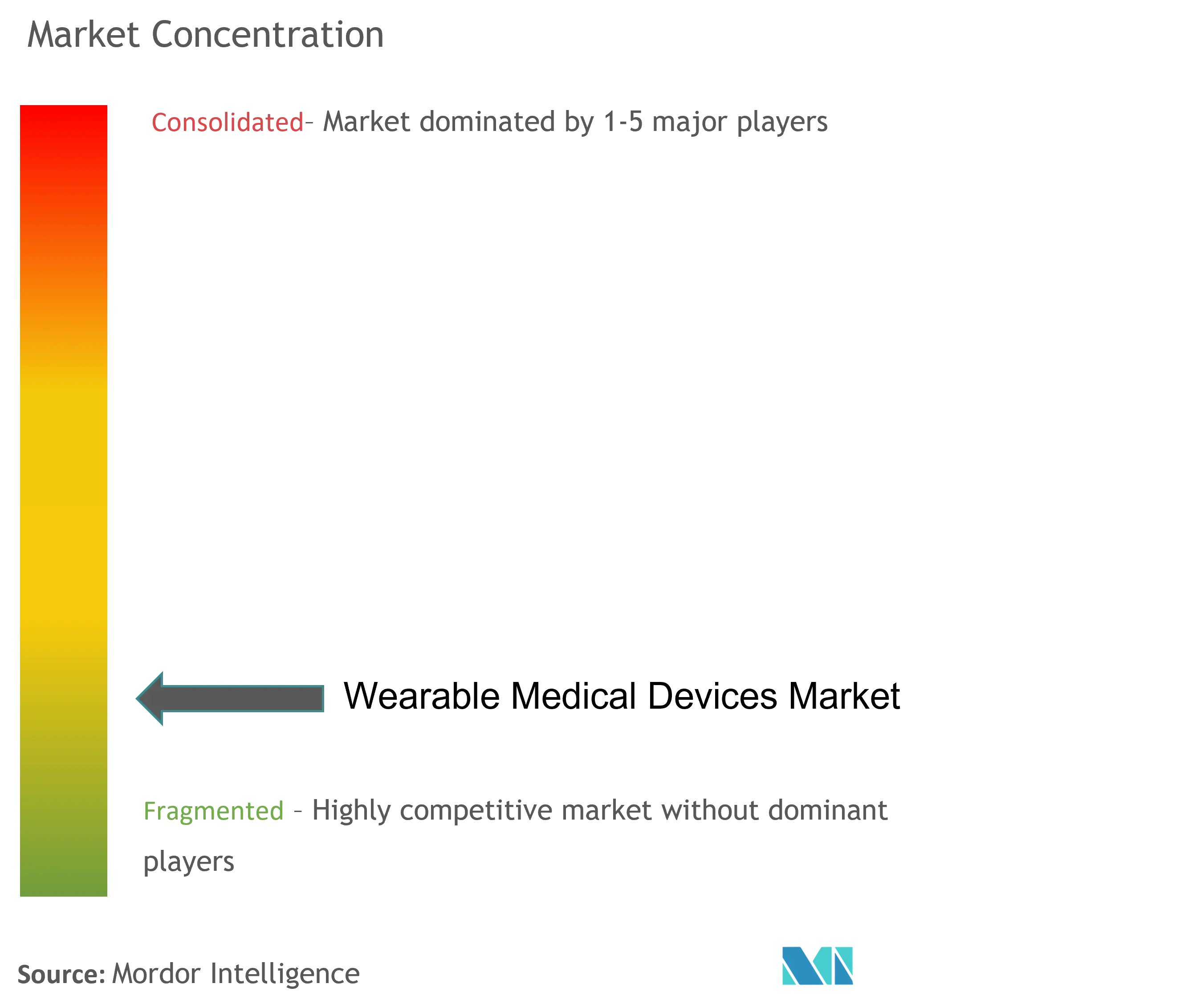
Wearable Medical Devices Market News
- November 2022: Zepp Health launched its India-exclusive smartwatch, the Amazfit Pop 2. The fitness wearable is available on the e-commerce platform Flipkart.
- October 2022: OnePlus, a Chinese smartphone manufacturer, launched OnePlus Nord watch wearable device under its Nord category. The OnePlus Nord Watch pairs with the N Health app on a smartphone in order to measure and store step counts, calories burned, and sleep quality data.
Wearable Medical Devices Market Report - Table of Contents
1. INTRODUCTION
- 1.1 Study Assumptions and Market Definition
- 1.2 Scope of the Study
2. RESEARCH METHODOLOGY
3. EXECUTIVE SUMMARY
4. MARKET DYNAMICS
- 4.1 Market Overview
-
4.2 Market Drivers
- 4.2.1 Increasing Technological Advancements and Innovations
- 4.2.2 Increasing Per-capita Income in Developing Countries
- 4.2.3 Ease-of-use and Interpretation of Medical Devices
-
4.3 Market Restraints
- 4.3.1 High Cost of Wearable Devices
- 4.3.2 Unfavorable Reimbursement Issues
- 4.3.3 Lack of Awareness in Some Regions
-
4.4 Porter Five Forces
- 4.4.1 Threat of New Entrants
- 4.4.2 Bargaining Power of Buyers/Consumers
- 4.4.3 Bargaining Power of Suppliers
- 4.4.4 Threat of Substitute Products
- 4.4.5 Intensity of Competitive Rivalry
5. MARKET SEGMENTATION (Market Size by Value - USD million)
-
5.1 By Device Type
- 5.1.1 Diagnostic Devices
- 5.1.1.1 Vital Sign Monitoring Devices
- 5.1.1.2 Sleep Monitoring Devices
- 5.1.1.3 Electrocardiographs Fetal and Obstetric Devices
- 5.1.1.4 Neuromonitoring Devices
- 5.1.2 Therapeutic Devices
- 5.1.2.1 Pain Management Devices
- 5.1.2.2 Rehabilitation Devices
- 5.1.2.3 Respiratory Therapy Devices
- 5.1.2.4 Other Therapeutic Devices
-
5.2 By Application
- 5.2.1 Sports and Fitness
- 5.2.2 Remote Patient Monitoring
- 5.2.3 Home Healthcare
-
5.3 By Product Type
- 5.3.1 Watch
- 5.3.2 Wristband
- 5.3.3 Ear Wear
- 5.3.4 Other Product Types
-
5.4 By Geography
- 5.4.1 North America
- 5.4.1.1 United States
- 5.4.1.2 Canada
- 5.4.1.3 Mexico
- 5.4.2 Europe
- 5.4.2.1 United Kingdom
- 5.4.2.2 Germany
- 5.4.2.3 France
- 5.4.2.4 Italy
- 5.4.2.5 Spain
- 5.4.2.6 Rest of Europe
- 5.4.3 Asia-Pacific
- 5.4.3.1 China
- 5.4.3.2 Japan
- 5.4.3.3 India
- 5.4.3.4 Australia
- 5.4.3.5 South Korea
- 5.4.3.6 Rest of Asia-Pacific
- 5.4.4 Middle East and Africa
- 5.4.4.1 GCC
- 5.4.4.2 South Africa
- 5.4.4.3 Rest of Middle East and Africa
- 5.4.5 South America
- 5.4.5.1 Brazil
- 5.4.5.2 Argentina
- 5.4.5.3 Rest of South America
6. COMPETITIVE LANDSCAPE
-
6.1 Company Profiles
- 6.1.1 Apple Inc.
- 6.1.2 Omron Corporation
- 6.1.3 Withings
- 6.1.4 Fitbit
- 6.1.5 MINTTIHEALTH
- 6.1.6 imec
- 6.1.7 Intelesens Ltd
- 6.1.8 AIQ Smart Clothing
- 6.1.9 Lifesense
- 6.1.10 Biobeat
- 6.1.11 Koninklinje Philips NV
- 6.1.12 Samsung Electronics Co. Ltd
- *List Not Exhaustive
7. MARKET OPPORTUNITIES AND FUTURE TRENDS
** Subject To AvailablityWearable Medical Devices Industry Segmentation
As per the scope of the report, wearable medical devices are autonomous devices capable of diagnosing or monitoring medical conditions combined with digital health information, typically worn over the body. These devices possess features such as noninvasive physiological sensors, data processing modules, medical feedback, and wireless data transmission capabilities. The Wearable Devices Market is Segmented by Device Type (Diagnostic Devices (Vital Sign Monitoring Devices, Sleep Monitoring Devices, Electrocardiographs Fetal and Obstetric Devices, Neuromonitoring Devices) and Therapeutic Devices), Application (Sports and Fitness, Remote Patient Monitoring, and Home Healthcare), Product Type (Watch, Wristband, Ear Wear, and Other Product Types), and Geography (North America, Europe, Asia-Pacific, Middle East and Africa, and South America). The report offers the value (in USD million) for the above segments. The market report also covers the estimated market sizes and trends for 17 different countries across major regions globally. The report offers the value (in USD million) for the above segments.
| By Device Type | Diagnostic Devices | Vital Sign Monitoring Devices |
| Sleep Monitoring Devices | ||
| Electrocardiographs Fetal and Obstetric Devices | ||
| Neuromonitoring Devices | ||
| By Device Type | Therapeutic Devices | Pain Management Devices |
| Rehabilitation Devices | ||
| Respiratory Therapy Devices | ||
| Other Therapeutic Devices | ||
| By Application | Sports and Fitness | |
| Remote Patient Monitoring | ||
| Home Healthcare | ||
| By Product Type | Watch | |
| Wristband | ||
| Ear Wear | ||
| Other Product Types | ||
| By Geography | North America | United States |
| Canada | ||
| Mexico | ||
| By Geography | Europe | United Kingdom |
| Germany | ||
| France | ||
| Italy | ||
| Spain | ||
| Rest of Europe | ||
| By Geography | Asia-Pacific | China |
| Japan | ||
| India | ||
| Australia | ||
| South Korea | ||
| Rest of Asia-Pacific | ||
| By Geography | Middle East and Africa | GCC |
| South Africa | ||
| Rest of Middle East and Africa | ||
| By Geography | South America | Brazil |
| Argentina | ||
| Rest of South America |
Wearable Medical Devices Market Research FAQs
How big is the Wearable Medical Devices Market?
The Wearable Medical Devices Market size is expected to reach USD 41.75 billion in 2024 and grow at a CAGR of 15.60% to reach USD 86.20 billion by 2029.
What is the current Wearable Medical Devices Market size?
In 2024, the Wearable Medical Devices Market size is expected to reach USD 41.75 billion.
Who are the key players in Wearable Medical Devices Market?
Lifesense, Apple, Samsung, Fitbit and Omron Corporation are the major companies operating in the Wearable Medical Devices Market.
Which is the fastest growing region in Wearable Medical Devices Market?
Asia Pacific is estimated to grow at the highest CAGR over the forecast period (2024-2029).
Which region has the biggest share in Wearable Medical Devices Market?
In 2024, the North America accounts for the largest market share in Wearable Medical Devices Market.
What years does this Wearable Medical Devices Market cover, and what was the market size in 2023?
In 2023, the Wearable Medical Devices Market size was estimated at USD 36.12 billion. The report covers the Wearable Medical Devices Market historical market size for years: 2021, 2022 and 2023. The report also forecasts the Wearable Medical Devices Market size for years: 2024, 2025, 2026, 2027, 2028 and 2029.
What are the key factors driving the Wearable Medical Devices Market?
The key factors driving the Wearable Medical Devices Market are a) Growing focus on preventive healthcare and chronic disease management b) Real-time data from wearables allows healthcare providers to remotely monitor patients and intervene promptly if necessary
Wearable Medical Devices Industry Report
The wearable medical devices market is on an upward trajectory, fueled by an aging demographic susceptible to various conditions, cutting-edge medical technology advancements, and a rise in injuries from sports and accidents. North America leads this surge, with the Asia-Pacific region not far behind, due to governmental efforts and an increase in chronic lifestyle diseases. Wearable medical device companies are at the forefront, innovating with smart wearables, including activity trackers and biosensors, to meet the growing demand for health-conscious gadgets among consumers. This burgeoning sector is set for substantial growth, driven by robust R&D efforts and the launch of innovative products designed to monitor essential health indicators, signaling a promising expansion for the global market. For detailed insights, Mordor Intelligence™ Industry Reports provide comprehensive analysis, including market share, size, revenue growth rate, and a forecast outlook, available as a free report PDF download.

